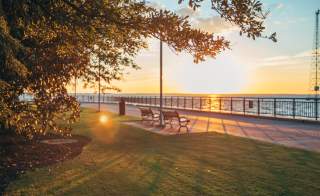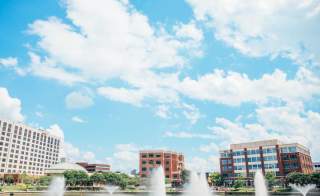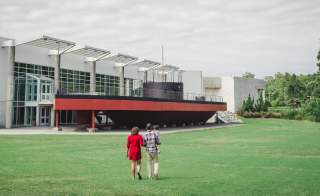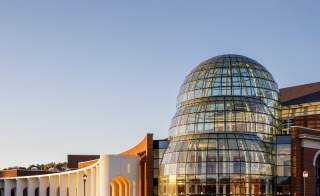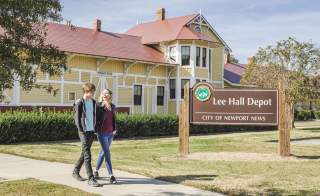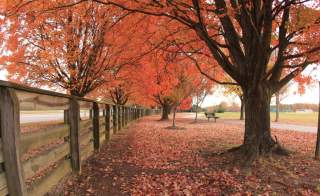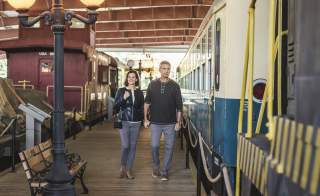Newport News is a city rich in history, culture, and outdoor beauty. Nestled along the James River and Chesapeake Bay, it offers a nice blend of urban attractions and natural surroundings.
As a visitor, you’ll find that Newport News is divided into several distinct sections, each with its own charm and character. Here’s a guide to help you explore the city’s diverse neighborhoods and discover what makes each one special.
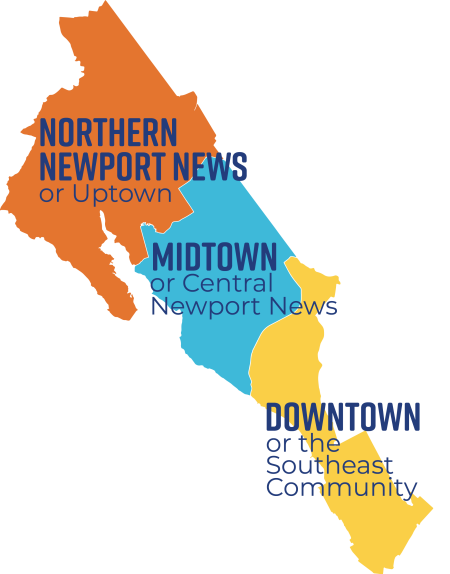
Downtown/Southeast Community
If you’re interested in maritime history, the downtown area is where you’ll want to start your exploration of Newport News. Here, you’ll find sites that showcase the city’s deep connection to shipbuilding and its military history. In fact, downtown was recently branded as The Yard District in a nod to Newport News Shipyard.
As the historical heart of the city, downtown Newport News is located along the James River, within sight of the shipyard. While the shipyard itself is not open for tours, the area provides a glimpse into the industrial might that shaped the city’s history. The first vessel built by the yard, launched in 1890, was the tugboat Dorothy, currently on display outside the yard.
While downtown, don’t miss Victory Landing Park with its amazing views of the James River or landmarks like the Victory Arch, a memorial to World War I veterans. These points of interest are ideal for history buffs who want to experience Newport News’ industrial and shipbuilding legacy.
From here, visitors can explore other historical sites and museums, such as Pinkett’s Beach at the foot of Jefferson Avenue, which became a hub of the Black community in the segregated 1950s, and the James A. Fields House, the restored home of a prominent African American lawyer and leader during the late 19th century.
Huntington Park, located a little north of downtown, is a popular spot that offers a small public beach on the James River, one of the longest fishing piers on the East Coast, a large playground for children, and the Virginia War Museum, which highlights America’s military past from 1775 to present.
Continuing northwest on Warwick Boulevard, you’ll find Historic Hilton Village, a charming neighborhood on the National Register of Historic Places. Established during World War I to house shipbuilders, it’s now home to eclectic shops, antique stores, art galleries, cozy cafés, and fine dining. Walking through Hilton Village, you’ll notice its distinctive architecture and quaint streets, making it the perfect place for an afternoon of wandering. Don’t miss Hilton Pier for fishing and magnificent sunsets on the James River, along with the Peninsula Community Theatre for its live performances. Hilton Village offers a more laid-back vibe for those who appreciate small-town charm and history.
Historic Hilton Village
Listed on the National Register of Historic Places, Historic Hilton Village features quaint, locally-owned shops…
Virginia War Museum
American military history unfolds at the Virginia War Museum. Collections of artifacts, weapons, vehicles, uniforms…
James A. Fields House
James A. Fields (1844-1903) was a teacher, lawyer and member of the Virginia House of Delegates. The house was used…
Midtown/Central Newport News
Midtown is the city’s commercial and entertainment center, offering an abundance of shopping and dining opportunities. It’s a great place to experience the more modern side of Newport News, such as City Center at Oyster Point and Port Warwick, two shopping and dining hubs with a neighborhood “vibe.”
City Center is known for its beautiful five-acre fountain, around which you’ll often find people taking a leisurely stroll. Port Warwick’s hallmark feature is Styron Square, a three-acre green space where live music is performed weekly during the summer months.
Within central Newport News, you’ll also find Avenue of the Arts, which serves as the city’s cultural corridor. Along this route, you’ll have access to some of the best performing and visual arts the region has to offer.
Avenue of the Arts is essentially the section of J. Clyde Morris Boulevard that is closest to Warwick Boulevard, and includes Christopher Newport University’s Ferguson Center for the Arts, a major performance venue for theater, music and other cultural events, as well as CNU’s Torggler Fine Arts Center, where rotating exhibitions feature the work of national and international artists, along with the artwork on students, faculty, and locals – a great way to experience contemporary visual art in a collegiate setting.
This stretch of Newport News was nicknamed “Avenue of the Arts” to reflect the prominence of the performing and visual arts in this area. It’s also home to two world-class museums: The Mariner’s Museum & Park, which has exhibits on naval history, shipbuilding, and even artifacts from the Civil War ironclad at its USS Monitor Center and the Virginia Living Museum, which combines elements of a zoo, aquarium, and science center. The Mariners’ Park includes a beautiful five-mile walking trail around Mariners’ Lake, called the Noland Trail.
Midtown / Central Newport News is ideal for those seeking entertainment, dining, retail therapy, or some interactive museum fun. It’s the section of Newport News that highlights the city’s dedication to arts and culture.
The Mariners' Museum and Park
The Mariners' Museum and Park connects people to the world's waters, because through the waters we are connected to…
Virginia Living Museum
Our state's natural heritage is the star at the Virginia Living Museum. Here, visitors can see red wolves, beavers…
Mary M. Torggler Fine Arts Center
Serving the Christopher Newport community, Hampton Roads and all of Virginia, the Mary M. Torggler Fine Arts Center…
Northern Newport News/Uptown
Northern Newport News boasts some interesting attractions. Newport News Park, one of the largest municipal parks in the country, offers hiking and biking trails, fishing, boating, camping, historic sites dating back to the Civil War, archery ranges, and seasonal events, like the Children’s Festival of Friends each May and Fall-O-Ween every October.
Additionally, this part of the city is ideal for fishing and boating enthusiasts who want easy access to bodies of water, such as Deep Creek Landing Marina, which opens into the James River. It’s also home to Menchville Marina, where you can see local watermen heading out to fish or harvest oysters and crabs, providing a glimpse into the region’s maritime heritage. With ample opportunities to launch small boats and kayaks, this is the perfect area for water recreation. The serene waters of the James River and the surrounding marshlands offer beautiful views, especially at sunrise or sunset.
If military history interests you, Fort Eustis is an active Army installation with its own museum dedicated to the history of Army transportation. The U.S. Army Transportation Museum offers a unique look into the evolution of military logistics and transportation equipment, from early wagons to modern aircraft. A trip to this museum will appeal to history enthusiasts and those interested in the military’s role in shaping the region.
Riverview Farm Park is a large public park with open fields, playgrounds, walking trails, and picnic shelters. The park also features a soccer complex, so you may catch a local game or tournament while visiting.
Other key attractions include Lee Hall Mansion, a beautifully preserved antebellum home that offers guided tours and insights into Civil War-era life, and Historic Endview, one of the last remaining colonial buildings in Newport News. To learn about the impact of the railroad on Newport News, remember to visit Lee Hall Depot, the only remaining station of five that had been on the lower peninsula.
Travelers interested in seeing a quieter, more suburban side of Newport News must experience the northern end of the city, where natural beauty and opportunities for outdoor recreation abound. It’s ideal for those who want a more relaxed, local experience, particularly if you’re looking to enjoy water activities or a day in the park.
Newport News is a city with something for everyone! From historical landmarks and military museums to cultural arts centers and sprawling parks, each neighborhood offers a unique experience. Whether you’re here for a weekend or an extended stay, make sure to explore these diverse sections to get a true sense of what makes Newport News a hidden gem in coastal Virginia.
Lee Hall Depot
Lee Hall Depot was erected circa 1881 on the Chesapeake & Ohio rail line. After construction, the village of Lee…
U.S. Army Transportation Museum
The story of the Army's Transportation Corps, from horse-drawn wagons to all-terrain, armored vehicles, is told…

